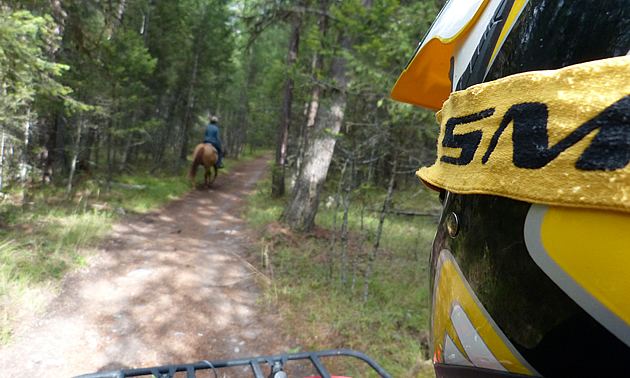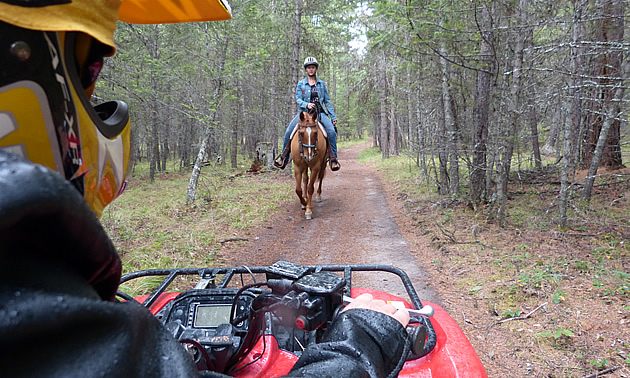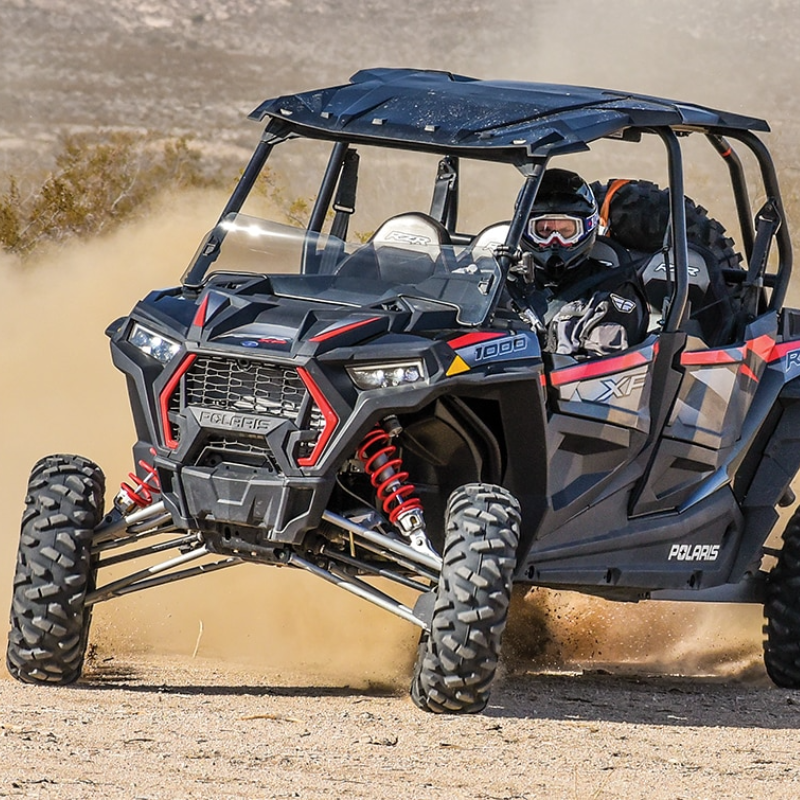Like north and south, ATVs and horses are polar opposites. One is a machine, controlled completely by its rider, and the other is a large, unpredictable animal with an instinct to turn and bolt when threatened. For obvious reasons, the two don’t always get along, yet both are popular ways to enjoy the backcountry. And whether you are an ATVer or a horseback rider, it is inevitable that one day you will meet.
So here are some tips on how to make the encounter safer:
Masters of the 180-degree spin
Horses are animals of flight. They are governed by an instinct that tells them to flee danger. Plus, they are extremely agile, able to turn on a dime. When this happens, it may be difficult for the rider to control the horse, and some horses will get so upset that they’ll toss their rider off. Not good.
So the onus is on you. As soon as you see a horseback rider approaching on the trail, pull over, stop and shut off the engine. Say “hello” to the rider. Your voice will let the horse know you are human and that there is no need to fret. Taking off your helmet also helps.
Carry on a friendly conversation with the rider while he/she is passing you by and let them gain some distance before restarting your engine. When you take off, go slowly.
The key here is communication, and some riders will motion for you to ride past them (particularly if you approaching from behind). This means they know their horse is used to off-road vehicles. It doesn’t mean, however, that you should rip by them at high speeds. Doing so may cause the horse to suddenly get anxious and kick out at you or spook. Ride by slowly, give the horse a wide berth, and again, don’t rev up your engine until you’ve put some distance between you and the horse and rider.
Expect the unexpected
Use common sense. Not every situation will be the same and not every horse will react the same way either.
“Horses are all different,” said Sharon Pickthorne, who is Chair of the Joint Trails and Access Committee of Horse Council BC. “Some will be trying to get close enough to see if you are carrying any goodies, others will be giving you a wide berth.”
Pickthorne also said corners and bends in the trails can be dangerous because the horse might not see you until you are too close to pass safely, so take ‘er easy in these situations if you can.
It does seem like a lot of work to pass a horseback rider on the trail, and we all have the same right to be there, but remember that if a conflict does arise, ATVers will likely earn a bad reputation or pay the ultimate price of losing our trails.
So if you’re on a multi-use trail, expect to meet horseback riders so that when you do, they smile and thank you for your courtesy rather than cursing you for being there.
Some tips for horseback riders
The same applies to horseback riders. Expect to see ATVers on a multi-use trail.
Remember, too, that ATVers can’t always hear you coming because hooves are quieter than engines. But you and your horse will almost always hear them, so use this as an opportunity to either move aside or step off the trail altogether, especially if you are worried the ATVer won’t be able to see you in time to pass safely.
When you do see ATVers, communicate with them as soon as possible. Motion for them to stop if you need them to, and when they do, be sure to thank them for their patience.
If your horse is acting spooky, you may need to do some circles to get his/her mind off the ATV. You could also try turning your head away from the direction of the ATV and looking at something else to get your horse refocused. If you’re nervous, your horse will pick up on it, so stay calm and breathe deeply.

When approaching a horse and rider from behind, go slowly and make sure they know you are there. Wait for the rider to give you instructions on how to pass safely. — Duke Armleder photo
If an ATVer is approaching from behind, turn your horse around so it can see where the noise is coming from. And when the ATVer gets close, be courteous and step aside to let him/her pass. Also, let the ATVer know as soon as possible if it’s safe to pass and give the rider clear instruction on how to do so.
Practice in the pasture
Of course, it is best to get your horse used to ATVs before you hit the trails, so if you know someone with an ATV, ask him or her to ride past you and your horse in a controlled environment until your horse gets used to the machine.
A positive experience for all
Whether you are an ATVer, a horseback rider, or both (like me!), getting along on the trails is a lot easier when everyone uses common sense, communication and courtesy.








Comments